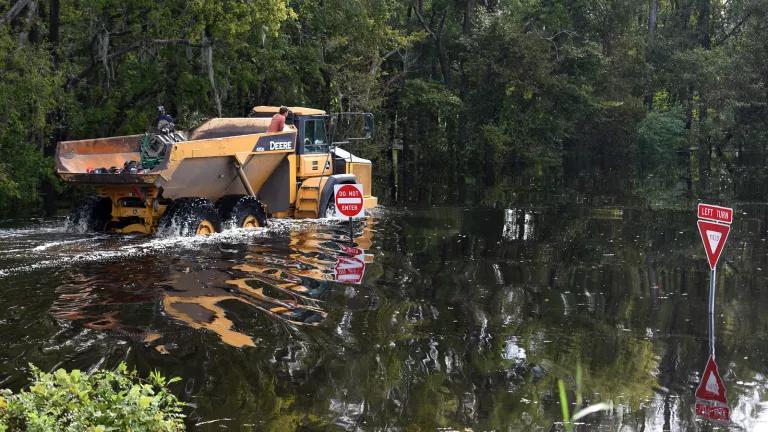Although President Obama has made the bipartisan issue of energy efficiency a cornerstone policy, at least six major energy-savings standards have been unaccountably delayed and these and other efficiency delays are costing consumers an estimated $4 billion in higher energy bills as a result. But a man scheduled for a Senate confirmation hearing tomorrow could make a big dent in those holdups.
Howard Shelanski, an economist and lawyer, is the president’s nominee to head the little-known White House Office of Information and Regulatory Affairs (OIRA), which reviews all regulatory standards issued by executive branch agencies before they become final. He will appear tomorrow before the Senate Committee on Homeland Security and Governmental Affairs.
At least four overdue energy efficiency measures (for commercial coolers and freezers, commercial refrigerators, industrial lighting fixtures and the like) have been languishing at OIRA for more than a year -- without any explanation of the cause of delay or an estimate on when they will be set free. Over the past two years, many more energy efficiency rules also have been stuck for long periods at OIRA. Two additional energy-savings measures are on hold at the Department of Energy (electric motors and external power supplies).
The reasons for these delays – which have also affected a number of other important environmental and public health standards – are obscure. But there’s an important new opportunity to cut through the red tape and fix this problem, with a new Energy secretary – Dr. Ernie Moniz – in place and Shelanski, who currently serves as director of the Federal Trade Commission’s Bureau of Economics, being nominated as the White House’s regulatory czar. Shelanski and Moniz should make eliminating these energy efficiency delays a top priority.
Under a longstanding federal law, the Department of Energy (DOE) sets minimum energy efficiency performance levels for household appliances such as refrigerators, dish washers, and air conditioners and for commercial equipment like motors and pumps. As a result, these products waste less energy while still providing the same level of service and comfort. Consumers benefit through lower energy bills, and global warming and other harmful power plant emissions are reduced or avoided. In many instances, DOE adopts efficiency levels that are the product of consensus negotiations between manufacturers, states, consumer groups, utilities, and energy efficiency advocates. Under legislation signed into law by President Reagan, DOE must meet a specific schedule for updating these energy-saving measures to ensure the required levels can reflect advances in efficiency technologies.
Refrigerators are a prime example of the success story from DOE energy efficiency standards. Today’s models use a staggering 80 percent less electricity than fridges in the 1970s, while the purchase price (adjusted for inflation) has gone down and their size and special features have increased. Meanwhile, our food remains just as cold. What’s not to like with this type of progress?
Indeed, in a New York Times opinion piece last year, the former OIRA administrator, Cass Sunstein, praised the benefits of energy efficiency standards:
"[R]ecent rules from the Department of Energy are requiring greater energy efficiency from appliances like refrigerators, washing machines and small motors. For these rules as well, the monetary benefits dwarf the costs, and they include large savings to consumers as well as pollution reductions. There is a lot more to achieve in the area of energy efficiency, especially as technologies advance and continue to transform the once-impossible into the eminently doable."
But, while the Obama administration finalized a record-setting number of energy efficiency standards in the first two years of the president’s first term, progress has slowed considerably since then. The four rules stuck at OIRA have been under review for more than a year without any explanation for the delay. Under an Executive Order, OIRA is supposed to complete its reviews within 90 days.
Although two energy efficiency rules (electric motors and external power supplies) are stalled at DOE itself, two others – for distribution transformers and microwave ovens – emerged from OIRA review and were recently finalized by DOE. That’s great news, but both were issued considerably behind schedule and all energy efficiency delays have lasting repercussions:
- First, each holdup in each energy efficiency rules means more wasted energy and higher consumer energy bills. The Appliance Standards Awareness Project (ASAP) runs a “lost consumer benefits from delayed efficiency standards” clock on its website that reports consumers are down over $4 billion in higher energy bills because of efficiency standards stuck at OIRA or DOE. These lost savings can never be recaptured.
- Second, each delay means more global warming pollution, smog, and acid rain. ASAP calculates the OIRA delays will result in about 44 million metric tons of additional carbon dioxide emissions, equivalent to the annual emissions of 9 million cars.
- Third, these delays also hurt appliance manufacturers, often based in the United States, who are usually open to advances in energy efficiency but need to know the timetable for new energy savings requirements well in advance so they can integrate them into their production processes. There’s a long tradition of negotiated standards agreed to by manufacturers, consumers, efficiency advocates and states, but the OIRA delays throw this process into a tailspin because it is impossible to predict when a negotiated standard will actually be adopted by DOE.
The consumer and environmental benefits of energy efficiency have been too long delayed by an administration that has made energy savings a priority. We urge the new OIRA director and Secretary Moniz to fix this problem fast.




